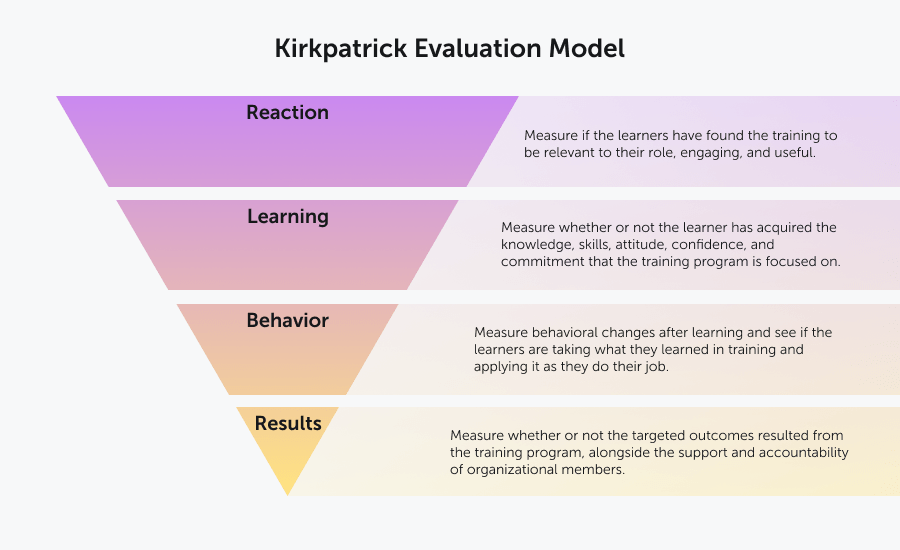
Discover the Kirkpatrick model and its benefits. Learn how to use it to evaluate training in your organization effectively.


Demand Generation & Capture Strategist, Valamis
January 17, 2022 · updated July 10, 2024
This guide will introduce the Kirkpatrick Model and the benefits of using this model in your training program. After reading this guide, you will be able to effectively use it to evaluate training in your organization.
The , also known as Kirkpatrick’s Four Levels of Training Evaluation, is a key tool for evaluating the efficacy of training within an organization. This model is globally recognized as one of the most effective evaluations of training.
The Kirkpatrick model consists of 4 levels: Reaction, learning, behavior, and results.
It can be used to evaluate either formal or informal learning and can be used with any style of training.
The Kirkpatrick Model has been widely used since Donald Kirkpatrick first published the model in the 1950s and has been revised and updated 3 times since its introduction. In 2016, it was updated into what is called the New World Kirkpatrick Model, which emphasized how important it is to make training relevant to people’s everyday jobs.

Understand learning data and receive a practical tool to help apply this knowledge in your company.

The first level is learner-focused. It measures if the learners have found the training to be relevant to their role, engaging, and useful.
There are three parts to this:
Reaction is generally measured with a survey, completed after the training has been delivered. This survey is often called a ‘smile sheet’ and it asks the learners to rate their experience within the training and offer feedback.
Some of the areas that the survey might focus on are:
This level focuses on whether or not the learner has acquired the knowledge, skills, attitude, confidence, and commitment that the training program is focused on.
These 5 aspects can be measured either formally or informally.
For accuracy in results, pre and post-learning assessments should be used.

Get a handy printable form for evaluating training and course experiences.
This step is crucial for understanding the true impact of the training.
It measures behavioral changes after learning and shows if the learners are taking what they learned in training and applying it as they do their job.
It also looks at the concept of required drivers. That is, “processes and systems that reinforce, encourage and reward the performance of critical behaviors on the job.”
The results of this assessment will demonstrate not only if the learner has correctly understood the training, but it also will show if the training is applicable in that specific workplace.
This is because, often, when looking at behavior within the workplace, other issues are uncovered. If a person does not change their behavior after training, it does not necessarily mean that the training has failed.
It might simply mean that existing processes and conditions within the organization need to change before individuals can successfully bring in a new behavior.
This level focuses on whether or not the targeted outcomes resulted from the training program, alongside the support and accountability of organizational members.
For each organization, and indeed, each training program, these results will be different, but can be tracked using Key Performance Indicators. Some examples of common KPIs are increased sales, decreased workers comp claims, or a higher return on investments.
This level also includes looking at leading indicators. These are “short-term observations and measurements suggesting that critical behaviors are on track to create a positive impact on desired results.”
At all levels within the Kirkpatrick Model, you can clearly see results and measure areas of impact. This analysis gives organizations the ability to adjust the learning path when needed and to better understand the relationship between each level of training. The end result will be a stronger, more effective training program and better business results.

Understand learning data and receive a practical tool to help apply this knowledge in your company.
Did you like it? Help us spread the word!